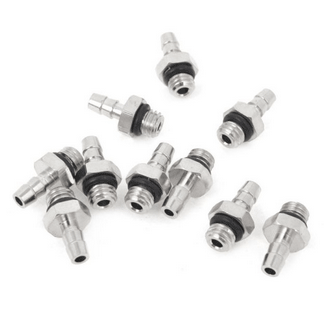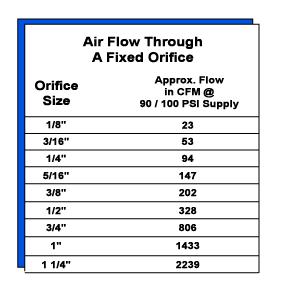Pressure drop is a very important factor to be aware of in compressed air systems. It can be caused by any obstruction to airflow that may appear across the various components within a compressed air system.
This page will provide you with all the relevant information about pressure drops and how to minimize them.
Table of Contents
- Pressure Drop in Air Compressors
- Pressure Drop Causes in Compressed Air Systems
- Estimating Pressure Drop
- Quick Guideline To Estimating Pressure Drop
- Calculating Pressure Drop
- FAQs (Frequently Asked Questions)
Pressure Drop in Air Compressors
Pressure drop is a phrase that refers to the instances where pressure loss occurs inside a compressed air system. This can happen at numerous points along the line and for various reasons.
As air travels through the airlines, the friction of the air moving along on the inner wall of the airline slows the air at the outside of the air stream, and the air in the middle moves faster as a result. This creates turbulence. Turbulence contributes to pressure drop.
Then, every fitting, every orifice the air travels through, every leak point the air travels past, slows the travel of the air and reduces the pressure that can be delivered. If air is moving more slowly, it takes longer to come up to pressure at a specific location.

Every fitting, every orifice, every airline, all contribute to pressure drop in compressed airflow. If the air-using application is using air faster than it can arrive at the point of use, the result of pressure drop is that the application will starve for compressed air negatively affecting the work performed.
Pressure Drop Rules
There are a few commonly accepted rules about pressure drop:
- The higher the flow rate at a constant pressure, the greater the pressure loss per length of pipe.
- The lower the inlet pressure with a constant flow, the greater the pressure loss per length of pipe.
- Regardless of the flow or the pressure, the smoother the I.D. of the pipe, the lower the loss over a given length of pipe.
Pressure Drop Causes in Compressed Air Systems
The characteristics or the condition of your airlines will affect any flow figures.
For example, aged black pipe used for airlines may contain an abundance of rust imparting a very rough surface to the inner diameter of the pipe. This will significantly increase the pressure drop, not to mention allowing chunks of rust to travel along with your compressed air, from time to time.
If there is considerable moisture in the mains, this too will increase pressure drop. The flowing compressed air has to overcome increased friction between it, the water, and the inner surface of the air pipe.
The airline size itself can also have a significant effect on pressure drop. Obvious scenarios that will cause significant pressure drop are having the air supply line at 3/8″ pipe size, and the application requiring 1/2″ lines. As air exits the 3/8″ line to the 1/2″ port, it expands, and the pressure drops.
As air moves from the compressor receiver or discharges through the plant mains, typically the airlines reduce in size, thus helping ensure that the air pressure that gets to the application is sufficient as long as the line size provides sufficient flow for the application.
When inspecting your system for problems that may be the source of pressure drop, check the following parts:
- Couplings: loose couplings will lead to expensive air loss and pressure drop
- Elbow: elbows are likely to cause pressure loss
- Filters: may become clogged
- Hoses: air leaks can form and cause pressure loss
- Lubricators: needs to be functioning properly
- Nozzles: leaks possible if not securely fastened
- Piping trees: where airflow is funnelled into two different streams, air leaks are possible
- Regulators: regulators control the passage of air so must perform without failure
- Tubes: cracks may appear on tubes and cause leaks
- Valves: must be tightened securely to avoid leaks
Air Fittings
Don’t forget your compressed air fittings! Air fittings affect the flow of air and the pressure drop due to potential leaks.
Every elbow, every Tee, and even every coupling cause turbulence in the air as it passes, and this increases the pressure loss. The loss through fittings is calculated by estimating how much longer the airline would be to correspond to the type and size of fitting.
Each size, and each type of fitting, has a different pressure drop flow factor. Further, any compressed air supply valves, depending on their type, and size, and shape, can significantly influence pressure drop in the compressed air.
Eliminate compressed air leaks and remove choke points between the source and end-use of your compressed air. Where possible plumb air to reduce elbow use, to help reduce pressure loss through air turbulence.
In a system that is designed and built correctly, between the compressor discharge and point of use, the norm is to see a 5-10 PSI drop. If you are seeing more pressure drops in your airlines than that, there is likely some problem with your compressed air plumbing.
Estimating Pressure Drop
Why bother estimating pressure drop in airlines? While estimating pressure drop in lengths of an airline is not too complex if the end application for the compressed air is not a critical one, and more complex if the end pressure and flow are critical, knowing what will come out of the airline at the air tool or air-use application can be important.
Having said that, if the air-using application demands an exact and certain flow and pressure, then I think you would be wise to get the industrial air professionals involved.
If close will suit then this following information will be useful.
- SMART DUAL INPUT – RISEPRO® manometer can easily measure the differential pressure with its dual input probes.
- RANGE & RESOLUTION – Measures +/- 2.000psi (0.001 resolution) with accuracy +/-0.3% in full scale
- MAX PRESSURE – 10psi (Can resist up to 10psi but may not show readings when over 2psi)
Prices pulled from the Amazon Product Advertising API on:
Product prices and availability are accurate as of the date/time indicated and are subject to change. Any price and availability information displayed on [relevant Amazon Site(s), as applicable] at the time of purchase will apply to the purchase of this product.
For the following orifice flow chart, I researched numbers from quite a few sources, and the figures shown are an average of those.
I can understand folks being puzzled about estimating pressure drop. One of the sources says that the air is measured in SCFM, another one says that it is CFM, and still another uses ACFM. So, even the experts, among whom I do not count myself, are not able to provide consistent information.
Air Flow Through An Orifice
As a guide to help you determine pressure drop, first check the airflow through the orifice that is the same size (or close) to the I.D. of your selected airline. The purpose is to ensure that the expected airflow rating will be more than enough to run your application(s).
The chart assumes that the air supply is 90 / 100 PSI, the air temperature is 70 deg. F. and there is virtually no pressure drop in the line as the orifice opens immediately to the atmosphere from the compressed air supply.

Once you’ve selected what you think will be the ideal supply line I.D., one that will provide the flow capacity that your air tools or air circuit will require over the distance the line must travel, you then must consider estimating the pressure drop in your air system, to make sure you have allowed enough extra flow capacity for the line losses you will experience.
Quick Guideline To Estimating Pressure Drop
The following guidelines will help you guesstimate pressure drop without using complex formulas:
- If your air line is up to 3/4″ I.D., then assume a loss of up to 10% of your available air pressure for every 100′ of air line
- If your air line is between 1″ – 2″ I.D. then assume 5% loss per 100′ of air line
- For air line 2 1/4″ and up assume a 3% pressure drop per 100′ of air line and you should be safe
Making Estimating Pressure Drop For Fittings Simple
To make it simple, and to err on the side of caution, if I were estimating pressure drop for the fittings in my supply airline, I would factor in 5′ (five feet) of an extra airline for every fitting, to allow for fitting caused pressure drop.
If I had 20 fittings from my compressor to my application, that would be the equivalent of an additional 100′ of airline added to the total airline length I would use to figure my pressure drop over that distance.
In the larger fitting sizes, the pressure drop caused by the air fitting is less, but for simplicity’s sake, I would still use the factor of 5 feet of airline length for every fitting in the air circuit.
Calculating Pressure Drop
Now if you’re wanting to find out what is the actual pressure drop? And not just have an estimate.
The standard compressed air pressure drop equation for calculating the likely pressure difference between the compressor and the end application is the “empirical formula” which is:
dp = 7.57 q 1.85 L 104 / (d5p)
Where:
dp = drop in pressure
q = air volume
L = pipe length
d = inside diameter of the pipe
p = starting pressure
Though a lot of people may be put off by its complexities. The formula does not take into account bends along the piping or the possibility of flow reduction within air pipes. The interior surfaces of pipes and how they are laid across an air system are both likely causes of turbulence during system operation.
Another place to look is online to find a calculator – www.kaeser.com/Online_Services/Toolbox/Pressure_drop/default.asp offers an online chart into which you can put the parameters of your airlines, and it will calculate pressure drop for you.
FAQs (Frequently Asked Questions)
Yes, the longer the length of the air hose, the greater the impact of the turbulence on the flow of air. The net loss of compressed airflow due to turbulence across a lengthy distance results in pressure drop.
Pressure drop is caused by a number of reasons in a pipe. It can be due to loose fittings causing air leaks, faulty components along the distribution network, turbulence due to rough inside surfaces of the pipe, or even ruptures or cracks in components.
If you have any questions about air hose pressure drop, please leave a comment below, with a photo if applicable, so that someone can help you!

